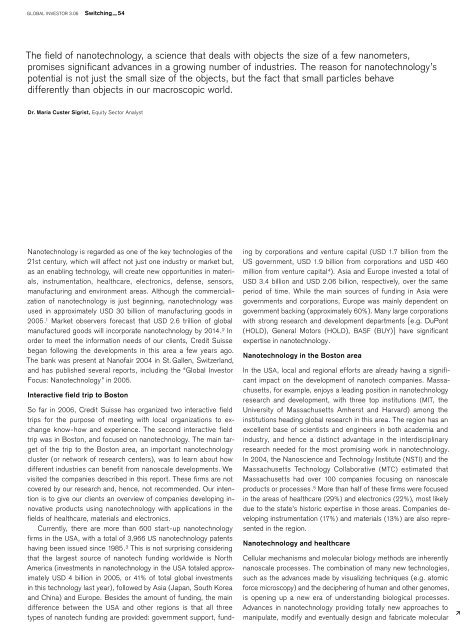Banking for 7 billion and 7 million
New challenges and opportunities of globalization Global Investor, 03/2006 Credit Suisse
New challenges and opportunities of globalization
Global Investor, 03/2006
Credit Suisse
You also want an ePaper? Increase the reach of your titles
YUMPU automatically turns print PDFs into web optimized ePapers that Google loves.
GLOBAL INVESTOR 3.06 Switching — 54<br />
The field of nanotechnology, a science that deals with objects the size of a few nanometers,<br />
promises significant advances in a growing number of industries. The reason <strong>for</strong> nanotechnology’s<br />
potential is not just the small size of the objects, but the fact that small particles behave<br />
differently than objects in our macroscopic world.<br />
Dr. Maria Custer Sigrist, Equity Sector Analyst<br />
Nanotechnology is regarded as one of the key technologies of the<br />
21st century, which will affect not just one industry or market but,<br />
as an enabling technology, will create new opportunities in materials,<br />
instrumentation, healthcare, electronics, defense, sensors,<br />
manufacturing <strong>and</strong> environment areas. Although the commercialization<br />
of nanotechnology is just beginning, nanotechnology was<br />
used in approximately USD 30 <strong>billion</strong> of manufacturing goods in<br />
2005. 1 Market observers <strong>for</strong>ecast that USD 2.6 trillion of global<br />
manufactured goods will incorporate nanotechnology by 2014. 2 In<br />
order to meet the in<strong>for</strong>mation needs of our clients, Credit Suisse<br />
began following the developments in this area a few years ago.<br />
The bank was present at Nanofair 2004 in St. Gallen, Switzerl<strong>and</strong>,<br />
<strong>and</strong> has published several reports, including the “Global Investor<br />
Focus: Nanotechnology” in 2005.<br />
Interactive field trip to Boston<br />
So far in 2006, Credit Suisse has organized two interactive field<br />
trips <strong>for</strong> the purpose of meeting with local organizations to exchange<br />
know-how <strong>and</strong> experience. The second interactive field<br />
trip was in Boston, <strong>and</strong> focused on nanotechnology. The main target<br />
of the trip to the Boston area, an important nanotechnology<br />
cluster (or network of research centers), was to learn about how<br />
different industries can benefit from nanoscale developments. We<br />
visited the companies described in this report. These firms are not<br />
covered by our research <strong>and</strong>, hence, not recommended. Our intention<br />
is to give our clients an overview of companies developing innovative<br />
products using nanotechnology with applications in the<br />
fields of healthcare, materials <strong>and</strong> electronics.<br />
Currently, there are more than 600 start-up nanotechnology<br />
firms in the USA, with a total of 3,966 US nanotechnology patents<br />
having been issued since 1985. 3 This is not surprising considering<br />
that the largest source of nanotech funding worldwide is North<br />
America (investments in nanotechnology in the USA totaled approximately<br />
USD 4 <strong>billion</strong> in 2005, or 41% of total global investments<br />
in this technology last year), followed by Asia (Japan, South Korea<br />
<strong>and</strong> China) <strong>and</strong> Europe. Besides the amount of funding, the main<br />
difference between the USA <strong>and</strong> other regions is that all three<br />
types of nanotech funding are provided: government support, funding<br />
by corporations <strong>and</strong> venture capital (USD 1.7 <strong>billion</strong> from the<br />
US government, USD 1.9 <strong>billion</strong> from corporations <strong>and</strong> USD 460<br />
<strong>million</strong> from venture capital 4 ). Asia <strong>and</strong> Europe invested a total of<br />
USD 3.4 <strong>billion</strong> <strong>and</strong> USD 2.06 <strong>billion</strong>, respectively, over the same<br />
period of time. While the main sources of funding in Asia were<br />
governments <strong>and</strong> corporations, Europe was mainly dependent on<br />
government backing (approximately 60%). Many large corporations<br />
with strong research <strong>and</strong> development departments [e.g. DuPont<br />
(HOLD), General Motors (HOLD), BASF (BUY)] have significant<br />
expertise in nanotechnology.<br />
Nanotechnology in the Boston area<br />
In the USA, local <strong>and</strong> regional ef<strong>for</strong>ts are already having a significant<br />
impact on the development of nanotech companies. Massachusetts,<br />
<strong>for</strong> example, enjoys a leading position in nanotechnology<br />
research <strong>and</strong> development, with three top institutions (MIT, the<br />
University of Massachusetts Amherst <strong>and</strong> Harvard) among the<br />
institutions heading global research in this area. The region has an<br />
excellent base of scientists <strong>and</strong> engineers in both academia <strong>and</strong><br />
industry, <strong>and</strong> hence a distinct advantage in the interdisciplinary<br />
research needed <strong>for</strong> the most promising work in nanotechnology.<br />
In 2004, the Nanoscience <strong>and</strong> Technology Institute (NSTI) <strong>and</strong> the<br />
Massachusetts Technology Collaborative (MTC) estimated that<br />
Massachusetts had over 100 companies focusing on nanoscale<br />
products or processes. 5 More than half of these firms were focused<br />
in the areas of healthcare (29%) <strong>and</strong> electronics (22%), most likely<br />
due to the state’s historic expertise in those areas. Companies developing<br />
instrumentation (17%) <strong>and</strong> materials (13%) are also represented<br />
in the region.<br />
Nanotechnology <strong>and</strong> healthcare<br />
Cellular mechanisms <strong>and</strong> molecular biology methods are inherently<br />
nanoscale processes. The combination of many new technologies,<br />
such as the advances made by visualizing techniques (e.g. atomic<br />
<strong>for</strong>ce microscopy) <strong>and</strong> the deciphering of human <strong>and</strong> other genomes,<br />
is opening up a new era of underst<strong>and</strong>ing biological processes.<br />
Advances in nanotechnology providing totally new approaches to<br />
manipulate, modify <strong>and</strong> eventually design <strong>and</strong> fabricate molecular

















